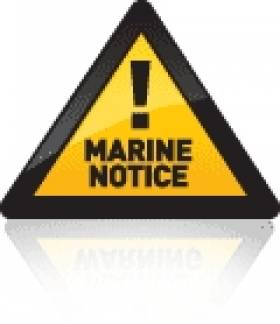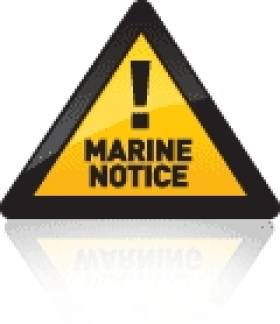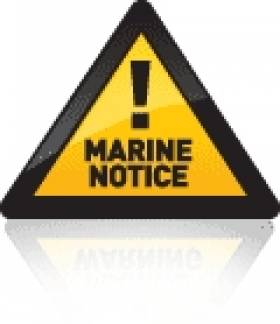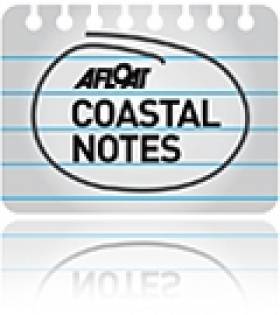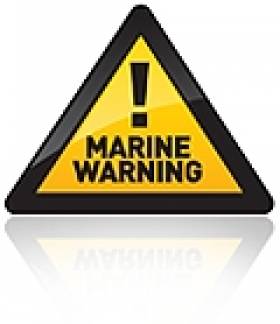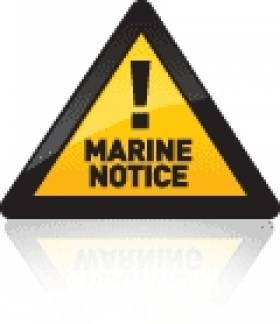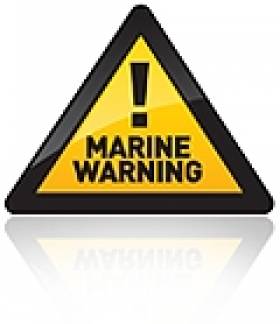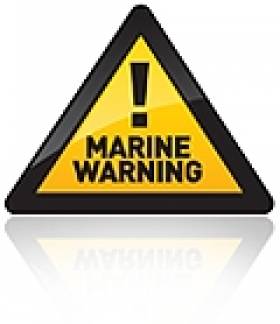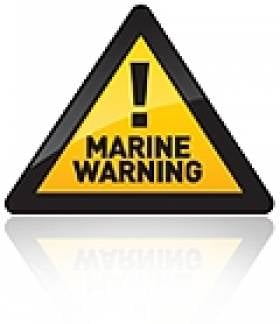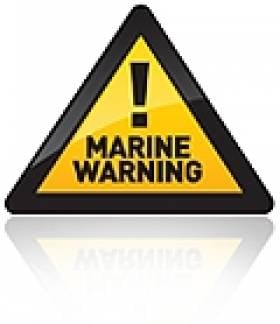Displaying items by tag: Corrib Gas field
Marine Notice: Deployment Of Waverider Buoy On Corrib Gas Field
#MarineNotice - The Department of Transport, Tourism and Sport (DTTAS) has been advised that Shell E&P Ireland Limited will be deploying a Waverider buoy in early-to-mid April in order to help predict sea conditions for the Corrib P6 well intervention work by the Ocean Guardian (Call Sign V7FF7).
The buoy size is 90cm in diameter, and will be deployed at the location (approximate, with 100m watch circle) 54° 20’N, 011° 05’W (WGS84), weather permitting. The water depth at this location is 360 metres. The Waverider buoy will remain on site for approximately three months.
The wave rider buoy is yellow in colour, and will flash yellow 5 times every 20 seconds. A photograph of what the buoy looks like in the water is included in Marine Notice 23 of 2014, a PDF of which is available to read or download HERE.
All vessels are requested to give the wave buoy a wide berth.
Marine Notice: Well Intervention On Corrib Gas Field
#MarineNotice - The Department of Transport, Tourism and Sport (DTTAS) advises that semi-submersible drilling rig Ocean Guardian (Call Sign V7FF7) will commence well intervention work for Shell E&P Ireland Limited on the Corrib Gas Field off the coast of Co Mayo around mid April 2014.
The rig is expected to be on location for a period of approximately 55 days, weather permitting. The vessel will be listening on VHF Channel 16 throughout the project.
Details of the planned position of the vessel for the wells are outlined in Marine Notice No 22 of 2014, a PDF of which is available to read or download HERE.
Marine Notice: Well Site Surveys On Corrib Gas Field
#MarineNotice - The latest Marine Notice from the Department of Transport, Tourism and Sport advises that the survey vessel MV Fugro Searcher will commence well site survey work for Shell E&P Ireland Limited on the Corrib Gas Field, off the coast of Co Mayo, around mid February 2014.
The vessel is expected to be on location for a period of approximately five days, weather permitting. The area to be surveyed is set out in the table and map included in Marine Notice No 17 of 2014, a PDF of which is available to read or download HERE.
The survey vessel has the Call Sign 3EUY6 and will be listening on VHF Channel 16 throughout the project.
All mariners are also reminded of the Safety Zone that is in place around the Corrib Gas Field development, referred to in Marine Notice No 21 of 2006, as well as their responsibilities under the International Collision Regulations (Marine Notice No 17 of 2007 gives general advice in relation to the activities of vessels engaged in survey work for hydrographic, seismic, fishing research and underwater operations).
All vessels, particularly those engaged in fishing, are requested to give the MV Fugro Searcher a wide berth of at least 500 metres and to keep a sharp lookout in the relevant areas.
Mayo Gas Terminal Licence Quashed By Court
#Corrib - RTÉ News reports that the Commercial Court has quashed a revised licence to operate Shell's gas terminal at Ballinaboy in Co Mayo in what's been seen as a victory for campaigners against the controversial Corrib Gas Project.
The move comes after the Environmental Protection Agency (EPA) conceded in court that a local man was entitled to an order against the licence.
Martin Harrington claimed that the EPA had failed to carry out a proper Environmental Impact Assessment of the relevant region on the north-west Mayo coast in a manner that met the requirements of relevant EU directives.
According to Business Etc, the EPA accepted the court's decision and will cover Harrington's legal costs.
Marine Notice: Well Inspections and Maintenance on the Corrib Gas Field
#MarineNotice - The Department of Transport, Tourism and Sport has been advised that the survey vessel the Normand Subsea (Call Sign: 2CQP8) will commence well works on the Corrib Gas Field, off the coast of Co Mayo, in early October 2013. The works will include replacement of subsea control modules and clamp system replacement.
The vessel, which is expected to be on location for a period of approximately 3 weeks, will be listening on VHF Channel 16 throughout the project. This Marine Notice will be updated if there are any significant changes to either the location or duration of the project.
All Mariners are reminded of the Safety Zone that is in place around the Corrib Gas Field development, referred to in Marine Notice No. 21 of 2006. The co-ordinates of the safety zone are:
|
Latitude (N) |
Longitude (W) |
|
54° 20’ 20.170” |
011° 03’ 26.819” |
|
54° 19’ 09.119” |
011° 02’ 54.963” |
|
54° 20’ 51.418” |
011° 02’ 15.465” |
|
54° 19’ 11.136” |
011° 04’ 15.419” |
All vessels, particularly those engaged in fishing, are requested to give the Normand Subsea a wide berth of at least 500 metres and to keep a sharp lookout in the relevant areas.
All vessels are required to comply fully with the International Regulations for the Prevention of Collisions at Sea and to manoeuvre their vessels accordingly. The attention of all is drawn to Marine Notice No. 17 of 2007, which gives general advice in relation to the activities of vessels engaged in survey work for hydrographic, seismic, fishing research and underwater operations.
Rock Placement at Corrib Gas Field Development – Marine Notice No. 44
Marine Notice No. 44 of 2013
Amended 11/09/2013
Notice to all Shipowners, Fishing Vessel Owners, Agents, Shipmasters, Skippers, Fishermen, Yachtsmen and Seafarers
Corrib Gas Field Development, Broad Haven Bay,
North West County Mayo, Ireland
The Department of Transport, Tourism and Sport has been advised that Rock Placement works will commence along the pipeline/umbilical route from 54°20.34'N, 011°03.51'W to 54°19'54.851"N, 010°00'16.033"W (WGS84). Work will commence in late-September 2013 and is expected to be completed within three weeks
Scope of works
Subsea Rock Installation to protect subsea infrastructure.
Vessel involved:-
MV Stornes , operated by Van Oord Offshore (VOO).
Call Sign: PCKX
IMO: 9549035
All vessels in the vicinity are requested to keep clear of the works as these works progress along the pipeline route and to comply with requests from support vessel. Furthermore, all vessels are requested to monitor and comply with the Radio Navigational Warnings that will be broadcast for the duration of the works. All vessels involved in the operations will be listening on VHF CH 16 throughout the project .
All vessels are required to comply fully with the International Regulations for the Prevention of Collisions at Sea and to manoeuvre their vessels accordingly. The attention of all is drawn to Marine Notice No. 17 of 2007 , which gives general advice in relation to the activities of vessels engaged in survey work for hydrographic, seismic, fishing research and underwater operations.
The International Regulations for Prevention of Collisions at Sea (COLREGS) are implemented in Irish law by the Merchant Shipping ( Collision Regulations) (Ships and Water Craft on the Water) Order 2012 [S.I. No. 507 of 2012], and the Signals of Distress (Ships) Rules 2012 [S.I. No.170 of 2012] . See Marine Notice No. 06 of 2013 . These Statutory Instruments may be purchased by mail order from Government Publications, Office of Public Works, 52 St. Stephen's Green, Dublin 2. Tel: (01) 6476834/1890-213434. They are also available online at: www.irishstatutebook.ie .
Marine Notice: Rock Placement at Corrib Pipeline
#MarineNotice - The Department of Transport, Tourism and Sport has been advised that rock placement works will commence along the pipeline/umbilical route at the Corrib Gas Field development off Co Mayo.
Work will commence in mid-September and is expected to be completed within three weeks.
The works vessel is MV Stornes, operated by Van Oord Offshore (Call sign: PCKX; IMO: 9549035), which will be installing subsea rock to protect the pipeline structure.
All vessels in the vicinity are requested to keep clear of the works as these works progress along the pipeline route and to comply with requests from support vessel.
Furthermore, all vessels are requested to monitor and comply with the Radio Navigational Warnings that will be broadcast for the duration of the works. All vessels involved in the operations will be listening on VHF Channel 16 throughout the project.
Full details of co-ordinates are included in Marine Notice No 44 of 2013, a PDF of which is available to read or download HERE.
Well Activity on the Corrib Gas Field
Marine Notice No. 40 of 2013
Notice to all Shipowners, Fishing Vessel Owners, Agents, Shipmasters, Skippers, Fishermen, Yachtsmen and Seafarers
The Department of Transport, Tourism and Sport has been advised that the light Well Intervention Vessel, “Well Enhancer” (Call Sign, 2ARS4) will conduct Wells activity involving equipment installation on the Corrib Gas Field, off the coast of Co. Mayo, around mid-August 2013. The vessel is expected to be on location for a period of approximately 5 days. The planned position of the vessel for the activity is as set out in the table below:
|
Well |
Activity |
Location of vessel (WGS84) |
|
18/25-1(P2) |
Equipment Installation |
Latitude: 54 o 19' 09.119" North
|
The vessel will be listening on VHF CH. 16 throughout the project.
In the event of any significant changes to either location or duration, this Marine Notice will be amended and re-issued.
All Mariners are reminded of the Safety Zone that is in place around the Corrib Gas Field development, referred to in Marine Notice No. 21 of 2006 .
All vessels, particularly those engaged in fishing, are requested to give the vessel a wide berth of at least 500 metres and to keep a sharp lookout in the relevant areas.
All mariners are reminded of their responsibilities under the International Collision Regulations and are reminded of Marine Notice No. 17 of 2007 , which gives general advice in relation to the activities of vessels engaged in survey work for hydrographic, seismic, fishing research and underwater operations.
The International Regulations for Prevention of Collisions at Sea (COLREGS) are implemented in Irish law by the Merchant Shipping ( Collision Regulations) (Ships and Water Craft on the Water) Order 2012 [S.I. No. 507 of 2012], and the Signals of Distress (Ships) Rules 2012 [S.I. No.170 of 2012] . See Marine Notice No. 06 of 2013 . These Statutory Instruments may be purchased by mail order from Government Publications, Office of Public Works, 52 St. Stephen’s Green, Dublin 2. Tel: (01) 6476834/1890-213434. They are also available online at: www.irishstatutebook.ie .
Director General,
Irish Maritime Administration,
Department of Transport, Tourism and Sport,
Leeson Lane, Dublin 2, Ireland.
Marine Notice: Drilling in Corrib Gas Field
#MarineNotice - The latest Marine Notice from the Department of Transport, Tourism and Sport (DTTAS) advises that a drill ship will begin intervention work for Shell E&P Ireland Ltd on the Corrib Gas Field from late June to early July.
The vessel West Navigator (Call sign 3ERR2) is expected to be on location for a period of 45 days, weather permitting, to work on a series of wells. Co-ordinates are detailed in Marine Notice No 24 of 2013, a PDF of which is available to read or download HERE.
All mariners are reminded of the 'safety zone' in place around the Corrib Gas Field development, and especially those engaged in fishing are requested to give the West Navigator a wide berth of at least 500 metres.
The vessel will be listening on VHF Channel 16 throughout the project.
This follows notice of umbilical installation works between the Corrib Gas Field at the mainland that will continue till July, as previously reported on Afloat.ie.
#MarineNotice - The latest Marine Notice from the Department of Transport, Tourism and Sport (DTTAS) advises that umbilical installation and associated works between the Corrib Gas Field and the mainland and Broad Haven Bay in Co Mayo will commence tomorrow 8 May.
The area of activity stretches along the route of the existing Corrib pipeline, and will continue till the umbilical pull-in to Glengad and subsequent lay away of the umbilical next month, followed by further tie-in works in the Corrib field to be completed by mid-July, weather permitting.
A number of work and service vessels will be used throughout the offshore works period, with various tasks from installing the main umbilical to post-lay jetting.
In order to create a safe working environment for the near-shore diving activities and the umbilical pull-in, a Safety Zone around the bellmouth (250m radius) will be identified with red marker buoys spaced at 75m interval around the circumference of the zone.
All vessels in the vicinity are requested to keep clear of the works as these works progress along the pipeline route and to comply with requests from support vessels and safety boats.
Furthermore, all vessels are requested to monitor and comply with the Radio Navigational Warnings that will be broadcast for the duration of the works. All vessels involved in the operations will be listening on VHF Channel 16 throughout the project.
Full details of co-ordinates of the work area and the work vessels involved are included in Marine Notice No 20 of 2013, a PDF of which is available to read or download HERE.


























